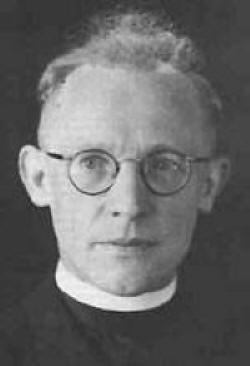

 Leonhard Roth, also called Leo (born 28 May 1904 in Saldenburg; † probably 22 June 1960 near Braz, Vorarlberg) was a German Catholic priest, Dominican with the religious name Korbinian and as an inmate nurse in dachau concentration camp. After the liberation from National Socialism, he was a pastor in Dachau and made a living as a delegate of the concentration camp priests of the Comité International de Dachau for the construction of the Dachau concentration camp memorial.
Leonhard Roth, also called Leo (born 28 May 1904 in Saldenburg; † probably 22 June 1960 near Braz, Vorarlberg) was a German Catholic priest, Dominican with the religious name Korbinian and as an inmate nurse in dachau concentration camp. After the liberation from National Socialism, he was a pastor in Dachau and made a living as a delegate of the concentration camp priests of the Comité International de Dachau for the construction of the Dachau concentration camp memorial.
Born at Saldenburg, Niederbayern, after studying German literature and philosophy in Berlin, Roth decided to become a priest. In 1931, at the age of 27, he was ordained as a Dominican monk in a monastery near Cologne. The Gestapo issued a warrant for his arrest in January 1937, (in the nazi-trial is written: "he visitet a brothel" - but it is improbable for a monk. It is rather a pretext to imprison thise priest) but he was able to flee to Switzerland.
He was captured by Swiss police in March 1941 and extradited to Germany, where he served a two year prison sentence. At the end of his term in 1943 the Gestapo committed him to the Dachau concentration camp instead of releasing him. The camp adminstration gave him the "black triangle" badge of the "asocials" because he was accused of homosexual conduct as well as anti-Nazi activity.
He was one of the few priests imprisoned in the Dachau KZ to survive the work caring for inmates dying of highly infectious typhus at the end of the war. Roth remained in Dachau as a priest for the SS men interned there by the US Army after July 1945. When that internment camp was dissolved and the Bavarian government converted the camp to housing for German refugees from Czechoslovakia, Poland, Hungary, Rumania, and Yugoslavia in 1948, Roth remained as their "curate" (he had been demoted from priest status).
A stern but well-liked pastor, he worked tirelessly to better the living conditions of the refugees. Around 1957 he joined the Dachau camp survivors' organization as a representative of the priests who had been imprisoned in the camp. By 1960 he was in heated conflict with the Catholic hierarchy in Bavaria. He was accused of having a homosexual relationship with an orphaned tenant who worked with him, but this was a lie. Relieved of his post in the refugee settlement, he took his own life in Braz, Vorarlberg.
My published books: